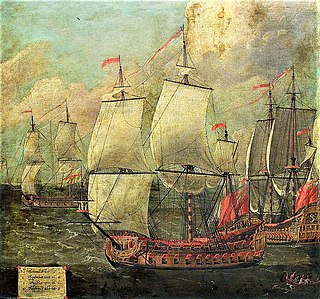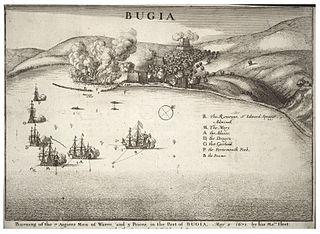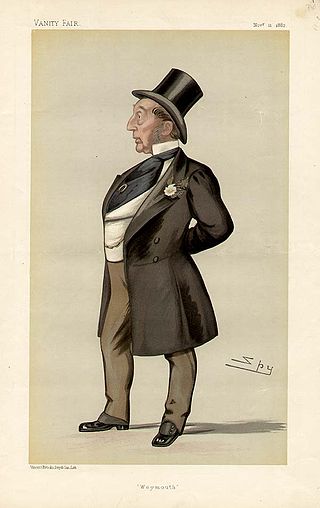
Sir William Penn was an English admiral and politician who sat in the House of Commons from 1660 to 1670. He was the father of William Penn, founder of the colonial Province of Pennsylvania, which is now the US Commonwealth of Pennsylvania.

Sir Thomas Myddelton (1586–1666) of Chirk Castle, Denbighshire, was an English-born Welsh landowner, politician, and military officer. He became a Member of Parliament in 1624; during the First English Civil War he was a prominent Parliamentarian general, despite having no previous military experience.
Sir Thomas Myddelton was a Welsh merchant who was Lord Mayor of London before becoming a Member of Parliament for London.

Vice Admiral Sir Christopher Myngs was an English naval officer and privateer, most notably in the Colony of Jamaica. He came from a Norfolk family and was a relative of Admiral Sir Cloudesley Shovell. Samuel Pepys' story of Myngs' humble birth, in explanation of his popularity, has now been evaluated by historians as being mostly fictitious in nature.

George Legge, 1st Baron Dartmouth PC was an English Royal Navy officer and peer who was appointed Admiral of the Fleet by James II of England in September 1688. However, he failed to intercept a Dutch invasion force under William III that landed at Torbay on 5 November 1688 and was dismissed following the Glorious Revolution.
Bristol was a 44-gun fourth rate vessel of the Commonwealth of England built under the 1651 Programme. She arrived too late for the First Anglo-Dutch War, however, was an active participant in the Second Anglo-Dutch War though in the Third she was no longer used as a line-of battle vessel and reverted to a role of cruising against privateers. She was lost in this role in the English Channel when she was captured by the French. Two weeks she was recaptured by the English and sank in 1709.

The Battle of Weymouth and the associated Crabchurch Conspiracy occurred in 1645, during the First English Civil War, when several royalist plotters within the twin towns of Weymouth and Melcombe on the Dorset coast conspired to deliver the ports back into the control of King Charles I.

HMS Assurance was a 32-gun fourth-rate of the English Navy, built by Peter Pett I at Deptford Dockyard and launched in 1646. She was in the Parliamentary force during the English Civil War, then the Commonwealth Navy and was incorporated into the Royal Navy after the Restoration in 1660. During her time in the Commonwealth Navy she partook in the Battles of Dover, Portland, Gabbard and Texel. She foundered in a gale at Woolwich in 1660 and was salved. After the Restoration she partook in the Battle of Lowestoffe, the Four Days Fight and the Texel (1673). She was reduced to a Fifth Rate in 1690 before being sold in 1698.
HMS Dragon was a 38-gun fourth rate of the English Navy; she became part of the Royal Navy after the Restoration, built by the Master Shipwright Henry Goddard at Chatham and launched in 1647. She was the first frigate to be built at Chatham.
HMS President was a 34-gun fourth-rate of the English Navy, built by Peter Pett I at Deptford Dockyard and launched in 1650. She was incorporated into the Commonwealth Navy in 1650. She partook in the Battle off Dover and Kentish Knock in 1652, the Battle of Portland, the Gabbard and Scheveningen in 1653. She was renamed Bonaventure in 1660. After the Restoration she was incorporated into the Royal Navy. She was present at the Battle of Lowestoft (1665), the Four Days Battle and the Oxfordness in 1666. She was rebuilt in 1666. She was present at the Battle of Martinique in 1667, Battle of Solebay (1672), Battle of Schooneveld and Texel in 1673, the Battle of Beachy Head in 1690, the Battle of Barfleur 1692.

Advice was one of six 40-gun fourth-rate frigates, built for the Commonwealth of England under the 1650 Programme, she would be transferred to the navy of the Kingdom of England upon the Restoration of the monarchy in May 1660. During her time with the Commonwealth Navy she would fight in two major fleet engagements of the First Anglo-Dutch War, this being the Battle of Portland and the Battle of the Gabbard. After the Restoration she would be involved in the Second Anglo-Dutch War specifically the Battle of Lowestoft and the St James Day Battle. She would also be present at the attack on the Vile or better known as Holmes Bonfire. She would see action against the Algerines at the Battle of Bugia. During the Third Anglo-Dutch War she would do battle at the Battle of Solebay, The Battle of Schooneveld and the Battle of Texel. She would also do battle against the French at the Battle of Bantry Bay. She would see service in both the West and East Indies before being rebuilt at Woolwich.
HMS Assistance was one of six 40-gun fourth-rate frigates, built for the Commonwealth of England under the 1650 Programme, after the Restoration of the monarchy in 1660 she was incorporated into the navy of the Kingdom of England. During her time in the Commonwealth Navy she partook in the First Anglo-Dutch war being present in the battles of Kentish Knock, Portland and The Gabbard. In the Mediterranean she was present at the Battle of Santa Cruz and the bombardment of Porto Farina, In the Second Anglo-Dutch War she was involved in the Battle of Lowestoft, Battle of Vagen and the St James Day Fight. She did not participate in fleet actions after this. She spent the rest of her service life undergoing several rebuilds and plying the waters as a cruiser protecting British trade and projecting British sovereignty. After nearly 95 years of Service she was sunk as a break water at Sheerness at the end of 1745.

The English ship Winsby was a 44-gun fourth-rate frigate, built for the navy of the Commonwealth of England at Great Yarmouth, and launched in February 1654. Winsby was named for the Parliamentarian victory at the Battle of Winceby (1643).

Admiral Sir Richard Haddock was an officer of the Royal Navy. He served during the Anglo-Dutch Wars, eventually rising to the rank of Admiral in August 1690. In Herge's Adventures of Tintin, Richard Haddock was one of the inspirations for Captain Haddock's 17th century ancestor, Sir Francis Haddock.

Sir Henry Edwards was a British Liberal Member of Parliament for Weymouth and Melcombe Regis from 1867 until 1885, when Weymouth and Melcombe Regis ceased to be a parliamentary borough.

Vice-Admiral John Baker was an officer of the Royal Navy and politician who sat in the House of Commons between 1713 and 1716. He rose to the rank of vice-admiral after service in the Nine Years' War and the War of the Spanish Succession.

Sir John Strangways of Melbury House, Melbury Sampford, Somerset, and of Abbotsbury in Dorset, was an English politician who sat in the House of Commons variously between 1614 and 1666. He supported the Royalist side in the English Civil War.

Giles Strangways of Melbury House in Somerset, was an English politician who sat in the House of Commons variously between 1640 and 1675. He fought on the Royalist side during the Civil War
Samuel Ashe was an English lawyer and politician who sat in the House of Commons in 1659 and from 1679 to 1681.
Captain Roger Cuttance was a Royal Navy officer who took a prominent role in the Anglo-Dutch Wars.











